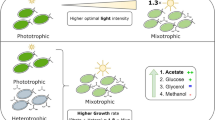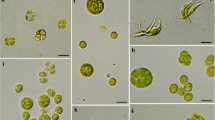Abstract
Beggiatoa alba strain B18LD was grown in continuous culture under heterotrophic conditions on acetate or acetate and asparagine and under mixotrophic conditions on acetate plus either 1 mM sodium sulfide or 1 mM sodium thiosulfate. Considerable differences were observed between the yields and the cell compositions of heterotrophic and mixotrophic cultures at all dilution rates tested. The dry weight yield per gram acetate utilized was approximately three times higher in the acetate-sulfide mixotrophic culture than in the acetate heterotrophic culture, whereas the poly-β-hydroxybutyric acid and carbohydrate contents were much higher in the heterotrophic cultures. The high yields (0.52–0.75, corrected for the weight of the sulfur) obtained with the mixotrophic cultures imply that the acetate was utilized mainly for biosynthesis. Thus, the oxidation of sulfide supplied energy. The addition of catalase to the chemostat cultures increased yields slightly, but it was insufficient to explain the differences between the heterotrophic and the mixotrophic cultures.
Similar content being viewed by others
References
Braunegg G, Sonnlietner B, Lafferty RM (1978) A rapid chromatographic method for the determination of poly-β-hydroxybutyric acid in microbial biomass. Eur J Appl Microbiol Biotechnol 6:29–37
Burton SD, Morita RY (1964) Effect of catalase and cultural conditions on growth of Beggiatoa. J Bacteriol 88:1755–1761
Cannon GC, Strohl WR, Larkin LM, Shively JM (1979) Cytochromes in Beggiatoa alba. Current Microbiol 2:263–266
Dawes EA, Senior PJ (1973) The role and regulation of energy reserve polymers in microorganisms. Adv Microbial Physiol 10:135–266
Dubois M, Gilles KA, Hamilton JK, Rebens PA, Smith F (1956) Colorimetric method for determination of sugars and related substances. Anal Chem 28:350–356
Jørgensen BB, Fenchel T (1974) The sulfur cycle of a marine sediment model system. Mar Biol 24:189–201
Kowallik U, Pringsheim EG (1966) The oxidation of hydrogen sulfide by Beggiatoa. Am J Bot 53:801–806
Leadbetter ER (1974) Family II. Beggiatoaceae. In: Buchanan RE, Gibbons NE (eds) Bergey's manual of determinative bacteriology, 8th ed. The Williams and Wilkins Co., Baltimore, pp 112–116
Lowry OH, Rosebrough NJ, Farr AL, Randall RJ (1951) Protein determination with the Folin phenol reagent. J Biol Chem 193:265–275
Payne WJ, Weibe WJ (1978) Growth yield and efficiency in chemosynthetic organisms. Ann Rev Microbiol 32:155–183
Pringsheim EG (1967) Die Mixotrophic von Beggiatoa. Arch Mikrobiol 59:247–254
Rittenberg SC (1972) The obligate autotroph — the demise of a concept. Anatonie van Leeuwenhoek. J Serol Microbiol 38:457–478
Scotten HL, Stokes JL (1962) Isolation and properties of Beggiatoa. Arch Mikrobiol 42:353–368
Smith DW, Rittenberg SC (1974) On the sulfur-source requirement for growth of Thiobacillus intermedius. Arch Microbiol 100:65071
Strohl WR, Larkin JM (1978) Enumeration, isolation, and characterization of Beggiatoa from freshwater sediments. Appl Environ Microbiol 36:755–770
Strohl WR, Larkin JM (1980) Sulfide oxidation and metabolism by Beggiatoa alba. Abstr Ann Meet Am Soc Microbiol K11, p 128
Winogradsky S (1887) Ueber Schwefelbakterien. Bot Ztg 45:489–507
Zehnder AJB, Wuhrmann K (1977) Physiology of a Methanobacterium strain AZ. Arch Microbiol 111:199–205
Author information
Authors and Affiliations
Rights and permissions
About this article
Cite this article
Güde, H., Strohl, W.R. & Larkin, J.M. Mixotrophic and heterotrophic growth of Beggiatoa alba in continuous culture. Arch. Microbiol. 129, 357–360 (1981). https://doi.org/10.1007/BF00406462
Received:
Accepted:
Issue Date:
DOI: https://doi.org/10.1007/BF00406462




